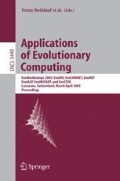Abstract
In this work we investigate the applicability of a multiobjective formulation of the Ab-Initio Protein Structure Prediction (PSP) to medium size protein sequences (46-70 residues). In particular, we introduce a modified version of Pareto Archived Evolution Strategy (PAES) which makes use of immune inspired computing principles and which we will denote by “I-PAES”. Experimental results on the test bed of five proteins from PDB show that PAES, (1+1)-PAES and its modified version I-PAES, are optimal multiobjective optimization algorithms and the introduced mutation operators, mut 1 and mut 2, are effective for the PSP problem. The proposed I-PAES is comparable with other evolutionary algorithms proposed in literature, both in terms of best solution found and computational cost.
Access this chapter
Tax calculation will be finalised at checkout
Purchases are for personal use only
Preview
Unable to display preview. Download preview PDF.
References
Anfinsien, C.B.: Principles that govern the folding of protein chains. Science 181, 223–230 (1973)
Simons, K.T., Kooperberg, C., Huang, E., Baker, D.: Assembly of of protein tertiary structures from fragments with similar local sequences using simulated annealing and Bayesian scoring function. J. Mol. Biol. 306, 1191–1199 (1997)
Hansmann, U.H., Okamoto, Y.: Numerical comparisons of three recently proposed algorithms in the protein folding problem. J. Comput. Chem. 18, 920–933 (1997)
Pendersen, J.T., Moult, J.: Protein folding simulations with genetic algorithms and a detailed molecular description. J. Mol. Biol. 169, 240–259 (1997)
Day, R.O., Zydallis, J.B., Lamont, G.B.: Solving the protein structure prediction problem through a multiobjective genetic algorithm. ICNN 2, 32–35 (2001)
Cui, Y., Chen, R.S., Wong, W.H.: Protein Folding Simulation using Genetic Algorithm and Supersecondary Structure Constraints. Proteins: Structure, Function and Genetics 31(3), 247–257 (1998)
Huang Enoch, S., Samudrala, R., Ponder Jay, W.: Ab Initio Folding Prediction of Small Helical Proteins using Distance Geometry and Knowledge-based Scoring Functions. J. Mol. Biol. 290, 267–281 (1999)
Foloppe, N., MacKerell Jr., A.D.: All-Atom Empirical Force Field for Nucleic Acids: I. Parameter Optimization Based on Small Molecule and Condensed Phase Macromolecular Target Data. J. Comput. Chem. 21, 86–104 (2000)
Dunbrack Jr., R.L., Cohen, F.E.: Bayesian statistical analysis of protein sidechain rotamer preferences. Protein Science 6, 1661–1681 (1997)
Sun, Z., Jang, B.J.: Patterns and conformations commonly occurring supersecondary structures (basic motifs) in Protein Data Bank. J. Protein Chem. 15, 675–690 (1996)
Sun, Z., Rao, X., Peng, L., Xu, D.: Prediction of protein supersecondary structures based on the artificial neural network method. Protein Eng. 10, 763–769 (1997)
Knowles, J.D., Corne, D.W.: The Pareto Archived Evolution Strategy: A New Baseline Algorithm for Pareto Multiobjective Optimisation. In: Proceedings of the 1999 Congress on Evolutionary Computation (CEC 1999), pp. 98–105 (1999)
Knowles, J.D., Corne, D.W.: Approximating the Nondominated Front Using the Pareto Archived Evolution Strategy. Evolutionary Computing 8(2), 149–172 (2000)
Cutello, V., Nicosia, G.: The Clonal Selection Principle for in silico and in vitro Computing. In: de Castro, L.N., Von Zuben, F.J. (eds.) Recent Developments in Biologically Inspired Computing (2004)
Deb, K., Pratap, A., Agarwal, S., Meyarivan, T.: A fast and elitist multiobjective genetic algorithm: NSGA-II. IEEE Trans. Evol. Computat. 6, 182–197 (2002)
Cooper, L.R., Corne, D.W., Crabbe, M.J.: Use of a novel Hill-climbing genetic algorithm in protein folding simulations. Comp. Bio. Chem. 27, 575–580 (2003)
Dandekar, T., Argos, P.: Identifying the tertiary fold of small proteins with different topologies from sequence and secondary structure using the genetic algorithm and extended criteria specific for strand regions. J. Mol. Biol. 256, 645–660 (1996)
Plotkin, S.S., Onuchic, J.N.: Understanding protein folding with energy landscape theory. Quarterly Reviews of Biophysics 35(2), 111–167 (2002)
Author information
Authors and Affiliations
Editor information
Editors and Affiliations
Rights and permissions
Copyright information
© 2005 Springer-Verlag Berlin Heidelberg
About this paper
Cite this paper
Cutello, V., Narzisi, G., Nicosia, G. (2005). A Class of Pareto Archived Evolution Strategy Algorithms Using Immune Inspired Operators for Ab-Initio Protein Structure Prediction. In: Rothlauf, F., et al. Applications of Evolutionary Computing. EvoWorkshops 2005. Lecture Notes in Computer Science, vol 3449. Springer, Berlin, Heidelberg. https://doi.org/10.1007/978-3-540-32003-6_6
Download citation
DOI: https://doi.org/10.1007/978-3-540-32003-6_6
Publisher Name: Springer, Berlin, Heidelberg
Print ISBN: 978-3-540-25396-9
Online ISBN: 978-3-540-32003-6
eBook Packages: Computer ScienceComputer Science (R0)

